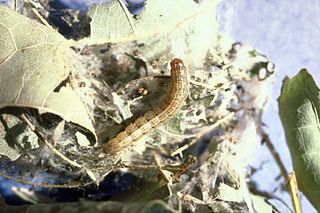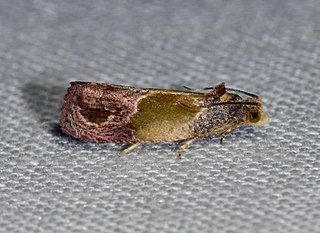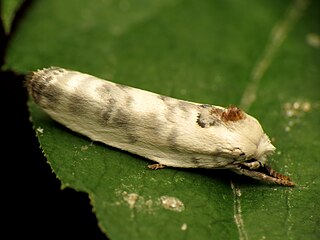Arequipa is a genus of moths of the family Crambidae. It contains only one species, Arequipa turbatella, which is found in North America, where it has been recorded from Alabama, Illinois, Maine, Maryland, North Carolina, Ohio, Ontario, Pennsylvania, Quebec and West Virginia.

Sciota subcaesiella, the locust leafroller moth, is a species of moth of the family Pyralidae. It is found in North America, including Maryland, New Jersey, Oklahoma, Iowa, North Carolina, South Carolina, Georgia, Alabama, Mississippi, Maine, New Hampshire, New York, Massachusetts, Pennsylvania, the District of Columbia, Virginia, Tennessee, Illinois, Missouri, Arkansas, Nova Scotia and Ontario.

Pococera asperatella, the maple webworm moth, is a moth of the family Pyralidae. It is found in North America, including Alabama, Illinois, Massachusetts, Minnesota, New Hampshire, New Jersey, North Carolina, Oklahoma, Ontario, Pennsylvania, South Carolina, Tennessee, Texas, Virginia and Wisconsin.

Pococera robustella, the pine webworm moth, is a species of moth of the family Pyralidae. It is found in southern Canada and the eastern United States from Minnesota to New England and south to Florida.

Acrolophus panamae, the Panama grass tubeworm moth, is a moth of the family Acrolophidae. It was described by August Busck in 1914. It is found in North America, including Alabama, Delaware, Florida, Georgia, Maryland, Mississippi, New Jersey, North Carolina, South Carolina and Virginia.

Ecpyrrhorrhoe puralis is a moth in the family Crambidae. It was described by South in 1901. It is found in China (Hubei). It is an introduced species in the eastern United States, where it has been recorded from Alabama, Georgia, Kentucky, Maryland, Mississippi, North Carolina, Pennsylvania, South Carolina, Tennessee and West Virginia.

Acleris macdunnoughi is a species of moth in the family Tortricidae. It is found in North America, where it has been recorded from Alberta, Kentucky, Maine, Massachusetts, Michigan, Minnesota, Montana, New Brunswick, North Carolina, Ohio, Ontario, Pennsylvania, Quebec, Tennessee, Vermont, Washington and West Virginia.

Acleris subnivana, the common acleris, is a species of moth of the family Tortricidae. It is found in North America, where it has been recorded from Arkansas, Illinois, Indiana, Kentucky, Maine, Maryland, Massachusetts, Michigan, Mississippi, New Brunswick, New Hampshire, New York, North Carolina, Ohio, Oklahoma, Ontario, Pennsylvania, Quebec, South Carolina, Tennessee, West Virginia and Wisconsin.
Pseudogalleria inimicella, the inimical borer moth, is a moth in the family Tortricidae. It was described by Zeller in 1872. It is found in North America, where it has been recorded from Alabama, Arkansas, Florida, Georgia, Illinois, Indiana, Kentucky, Maine, Maryland, New Hampshire, North Carolina, Ohio, Oklahoma, Ontario, South Carolina, Tennessee, Texas and West Virginia.

Elaphria grata, the grateful midget moth, is a moth of the family Noctuidae. It is found in North America, where it has been recorded from Alabama, Arkansas, Connecticut, Delaware, Florida, Georgia, Illinois, Indiana, Iowa, Kansas, Kentucky, Maine, Maryland, Massachusetts, Mississippi, Missouri, New Jersey, New York, North Carolina, Ohio, Oklahoma, Ontario, Pennsylvania, South Carolina, Tennessee, Texas, Virginia, West Virginia and Wisconsin.

Eumarozia malachitana, the sculptured moth, is a species of moth of the family Tortricidae. It is found in eastern North America, where it has been recorded from Alabama, Arkansas, California, Florida, Georgia, Illinois, Indiana, Iowa, Kentucky, Louisiana, Maine, Maryland, Massachusetts, Minnesota, Mississippi, Missouri, New Jersey, North Carolina, Ohio, Oklahoma, Ontario, Pennsylvania, South Carolina, Tennessee, Texas, Virginia and West Virginia.

Glyphidocera juniperella, the juniper tip moth, is a moth of the family Autostichidae. It is found in North America, where it has been recorded from Alabama, Florida, Indiana, Louisiana, Maryland, Mississippi, Oklahoma, South Carolina, Tennessee and West Virginia.

Meganola phylla, the coastal plain meganola moth, is a moth of the family Nolidae. It is found in North America, where it has been recorded from Alabama, Florida, Georgia, Illinois, Indiana, Maine, Maryland, Mississippi, New Jersey, North Carolina, Ohio, Oklahoma, Ontario, South Carolina, Tennessee, Virginia and West Virginia.

Metaxaglaea viatica, the roadside sallow moth, is a moth of the family Noctuidae. It is found in North America, where it has been recorded from Alabama, Arkansas, Florida, Georgia, Illinois, Indiana, Kansas, Kentucky, Maine, Maryland, Massachusetts, Michigan, New Hampshire, New Jersey, North Carolina, Ohio, Oklahoma, South Carolina, Tennessee, Texas, Virginia, West Virginia and Wisconsin.

Mompha circumscriptella, the circumscript mompha moth, is a moth in the family Momphidae. It is found in North America, where it has been recorded from Alabama, Arkansas, British Columbia, California, Florida, Georgia, Illinois, Indiana, Iowa, Kansas, Kentucky, Louisiana, Maine, Maryland, Mississippi, Missouri, Nebraska, New Jersey, North Carolina, Ohio, Oklahoma, South Carolina, Tennessee, Texas and West Virginia.

Glena plumosaria, the dainty gray moth or plumose gray moth, is a species of moth in the family Geometridae. It is found in North America, where it has been recorded from Alabama, Florida, Georgia, Indiana, Iowa, Kentucky, Maryland, New Jersey, North Carolina, Ohio, South Carolina, Tennessee and Virginia.

Ecliptopera atricolorata, the dark-banded geometer moth, is a moth of the family Geometridae. It is found in North America, where it has been recorded from Alabama, Arkansas, Florida, Georgia, Indiana, Kentucky, Maryland, Mississippi, North Carolina, Ohio, Pennsylvania, South Carolina, Tennessee, Virginia and West Virginia.

Antaeotricha leucillana, the pale gray bird-dropping moth, is a moth in the family Depressariidae. It was described by Philipp Christoph Zeller in 1854. It is found in North America, where it has been recorded from New Hampshire, Massachusetts, New York, Pennsylvania, District of Columbia, Virginia, North Carolina, Georgia, Alabama, Arkansas, Missouri, Kansas, Illinois, Iowa, Texas, Oregon, Louisiana, Manitoba and Nova Scotia.
Antaeotricha humilis, the dotted anteotricha moth, is a moth in the family Depressariidae. It was described by Philipp Christoph Zeller in 1855. It is found in North America, where it has been recorded from Alabama, Arkansas, Florida, Georgia, Illinois, Indiana, Kansas, Kentucky, Louisiana, Maryland, Mississippi, New Jersey, North Carolina, Ohio, Oklahoma, South Carolina, Tennessee, Texas, Virginia and West Virginia.

Pococera militella, the sycamore webworm, is a species of pyralid moth in the family Pyralidae.

















